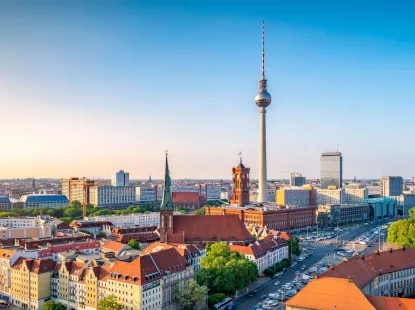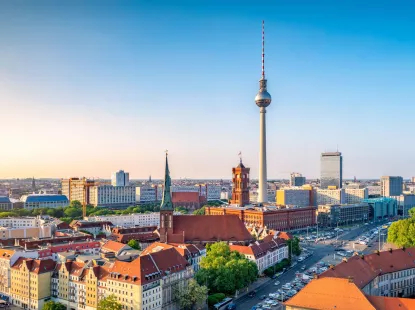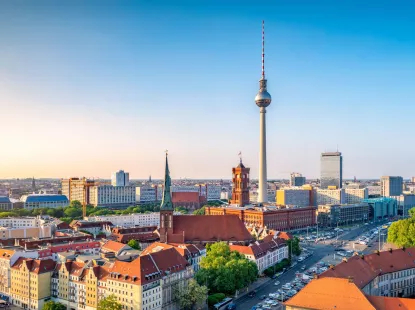

Italy
About the EURES Member
EURES Italy is looking for you!
EURES Italy promotes conscious, quality and circular professional mobility.
Its actions are aimed at matching demand and supply of labor according to the legal status of the subjects in mobility."
We have a wide array of job openings across many fields of expertise. EURES Italy is arranging this online recruitment event together with other countries, where you have the chance to connect with Italian companies and find job opportunities in Italy.
During the event we will provide you with information on both working and living in Italy and you will be able to meet some Italian companies looking for qualified candidates.
Recruitment consultants from EURES Italy will be available for chat during the day. You will also have the opportunity to reach out to some of the participating companies during the event.
Work in Italy is a Presidium created by the EURES Italy to provide adequate information and guidance to those who intend to have work experience in Italy for short or long term.
In EOJD events it operates mainly as an Info Point with the goal to offer a place (even virtual) to companies to meet their employment needs by meeting foreign candidates and at the same time support, both, to find the appropriate tools for a matching.
Many of EURES' services (in particular EURES on-line services) are freely available for any user with access to the web. If you already live and work in the EEA territory or Switzerland, you can contact a local or regional EURES Adviser to get advice. However, finding a job via EURES does not change the legal obligations and administrative procedures that may apply to non-EU citizens.
If you intend to move from a non-EEA country (except Switzerland) to live and work in the European Economic Area or Switzerland, often your own Ministry of Foreign Affairs can provide you with information on legal requirements to move abroad or refer you to useful information centres.
Work in Italy’s mission is to assist Italian companies in attracting and recruiting qualified foreign candidates in sectors, where Italian companies face skills shortages.
EURES offers a network of advisers to provide the information required by jobseekers and employers through personal contacts. There are more than 70 EURES advisers across Italy and the number is growing.
EURES advisers are trained specialists who provide the three basic EURES services of information, guidance and placement, to both jobseekers and employers interested in the European job market. They have developed specialised expertise in the practical, legal and administrative matters relating to mobility at national and cross-border levels. Generally they work within the Public Employment Service of each Region, or within other partner organisations in the EURES network.
If you are looking for more information about job searching in Italy you have the opportunity to get in direct contact with a Italian EURES adviser.
Each Friday 10:30-12:30 (CET) you can chat online with a consultant who can tell you about:
• Working and living conditions in Italy
• Job searching in Italy
• Your job opportunities etc.
You can log on by using the below link which will connect you to a EURES adviser. We look forward to chatting with you.
Chat with EURES Advisers (europa.eu)
EURES Italy present job possibilities in other EU/EEA countries and Switzerland for Italian jobseekers on https://www.cliclavoro.gov.it/pages/it/my_homepage/news/news_eventi/?ca…
The EURES Italy network condemns all forms of racism, discrimination and gender violence!
"WORK IN ITALY"
Work in Italy is a Presidium created by the EURES Italy to provide adequate information and guidance to those who intend to have work experience in Italy for short or long term.
This Presidium is dedicated to basic and first level information for EU nationals and Non-EU nationals interested in working in Italy.
Every citizen of the European Union has the right to move and reside freely in Italy or within the territory of another Member State other than that of which he/she is a national. Different formalities are required depending on the length of stay (exceeding three months or shorter stay).
EU nationals and on their own nationality. Due to complex immigration procedures, employers may as well decide not to go through your application. In order to be able to work in Italy and/or other European countries you will still have additional legal obligations and administrative procedures to go through to get access to the European labour market – and you’re not entitled to EURES mobility schemes.
General information
You can find some practical info about living and working in Italy here:
Foreigners in Italy
Insights/FAQ:
Living in Italy
Entry and residence visa into Italy
Tax identification number for foreign citizens
Insights/FAQ:
Study and training in Italy
Italian higher education system
Insights/FAQ:
Recognition of foreign professional qualifications: documentation
Recognition of foreign qualifications
Our guide san insights:
Entry and Residence for EU citizens
Entry and Residence Permit for NON EU Citizens
The macro sectors of seasonal Job in Italy
Procedures for entering Italy for work_Flows Decree 2022-2025
Excelsior information system set up by Unioncamere and ANPAL
https://excelsior.unioncamere.net/
For the 5-period 2022-2026, some 40 000 ICT technicians will be recruited mainly by the IT and telecommunications industry, together with mathematics and computer science specialists (30 000). There is also a need for technicians in organisational and financial activities (120-130 000), management, construction and environmental engineers, architects (some 50 000 in total), social science and management specialists (e.g. market analysts, marketing specialists and social media managers). The demand for engineers will top 50% in advanced business support services to companies in the consultancy sector and 20% (mechanical and electronic engineers) in the mechatronics and robotics sector, which will also require technicians, specialised mechanics and industrial equipment assemblers. The construction industry mainly needs workers specialising in construction and the maintenance of building structures and construction finishers (around 220 000), as well as construction engineers and technicians (around 25 000). Demand in the health sector will be concentrated on healthcare technicians (such as nurses, physiotherapists, radiologists and laboratory technicians), doctors and qualified healthcare and social services professionals.
Throughout Italy, 38.3% of the jobs on offer remain unfilled, particularly in the sectors of metalworking (52.6%), wood and furniture (50.4%), mechatronics (49.2%), IT and communications services (49.2%), textiles, clothing and footwear (47.4%). Finding candidates remains particularly difficult for businesses in the north-east (42.0%), followed by those in the north-west (41.1%), centre (36.3%) and south and islands (34.8%).
The professional groups within which it is very difficult to find candidates are, in descending order, pharmacists, biologists, and other life science specialists (55%), doctors and other healthcare specialists (46%), managers and directors (44%), IT, physics and chemical specialists (33%), metalworking and electromechanical workers (37%), beauty care workers (34%), workers specialising in the wood and paper industry (32%), social welfare workers (32%), specialist workers and plant operators in the textile, clothing and footwear industry (31%), chefs, waiters and other tourist service professions (23%), and reception, information and customer support workers (17%).
In May 2022, 444 310 recruitments are planned throughout Italy, the highest number of which is planned in the south and islands (133 260), followed by the north-west (114 840), centre (98 270) and north-east (97 940). The largest expected number of hires for commercial and service professions is in the north-east (42.4%) followed by the south and islands (40.6%); specialised workers, plant and machine operators are most needed in the north-west (25.9%), north-east, south and islands (24%); managers, specialised professions and technicians in the north-west (22.7%). Service jobs are most common in central Italy (40.1%).
Source: Excelsior Information System, Unioncamere-ANPAL, 2022
For more information click here
Employment and unemployment rate - October 2023
Unemployment figures are typically high in southern areas of Italy. ISTAT data for Q4 2022 show an unemployment rate for the 15-65 age group in the south of Italy of 14.6% in southern Italy, a very high rate compared to that in other parts of the country (central Italy 7.1%, and the north 4.8%).
The three regions with the highest unemployment rate in 2022 were Campania (17.4%), Sicily (16.9%) and Calabria (15%). In contrast, the lowest unemployment rates are found in the Autonomous Province of Bolzano (2.3%), Trentino-Alto Adige (3.1%) and the Autonomous Province of Trento (3.8%).
The gender employment gap remains among the highest in Europe. Female unemployment in Italy stands at 9.5% (Q4 2022) compared with 7.3% for men. The highest levels of female unemployment are recorded in southern Italy with 14.6%, followed by central Italy with 7.1% and the north 5.1%. The regions with the highest rates of female unemployment are Campania (20.3%) and Sicily (19.3%).
ISTAT, Quarterly Note on Employment Trends, Q3 2023.
For more information click here
OVERVIEW OF ITALY
- Population:
The resident population in Italy on 1 January 2023 is 58 million 851 thousand, 179 thousand less than the previous year, a reduction of 3‰. The The foreign population on 1 January 2023 is 5 million and 50 thousand, an increase of 20 thousand individuals (+3.9‰) over the previous year.
Most populous regions are Lombardy, Veneto, Lazio, Campania and Sicily. However, there is a demographic crisis, most evident in southern Italy, particularly in Molise, Basilicata and Calabria.
- Economy
Italy is 8°the largest economy in the world GDP (gross domestic product) 11.2 % of total EU GDP / per capita euro 28.500
Import of goods inside eu 60% (d - fr) outside eu 40% (China)
Main imported goods: chemicals, plastic, metals, medical products, oil, natural gas, automotive
Export of goods inside eu 56% (Germany France) outside EU 44% (USA) world leader as a manufacturer of machinery for industry main exported goods medical products, motor vehicles, fashion
- The labour market:
The Italian labour market differs widely between the regions: Industrial activity is mostly concentrated in the north and agriculture and tourismmainly in southern regions. The most typical sectors in order of GDP size (2021) are: services (GDP EUR 281 264 million), manufacturing (GDP EUR 76 359 million), construction (GDP EUR 20 261 million), agriculture (GDP EUR 7 729 million). The most common type of contract on offer is fixed-term (55.5%) and full-time.
The latest forecasts produced by the Excelsior Unioncamere/ANPAL Information System are 430 thousand new hirings expected by companies for November 2023 and 1.3 million for the November-January quarter, an increase compared to last year of +12.6% (+48 thousand hirings) in the month and +8.4% (+101 thousand hirings) in the quarter. Especially positive were the dynamics of tourism, with 66 thousand new hires in the month (+14 thousand compared to 12 months ago; +28.3%) and trade, with 68 thousand hires in November (+8 thousand; +13.2%). Keeping up the demand for labour, besides tourism and commerce, are personal services with 50 thousand hirings in the month (+5 thousand; +10.4% compared to a year ago). The dynamics of industry were more contained, with a total of 131 thousand recruitments planned for the month and 400 thousand for the November-January quarter, up b y +8.8% and 6.4% respectively, sustained above all by mechatronics, with 23 thousand workers sought (+3 thousand, +13.2%), and the fashion system, with 11 thousand entries (+3 thousand, +28.5%). Construction also held up well, with 45 thousand entries in the month (+4 thousand; +10.7% compared to November 2022). Fixed-term contracts are the most frequently offered form of contract with about 228,000 units, 52.9 per cent of the total, followed by permanent contracts (93,000 units, 21.7 per cent). The mismatch between demand and supply of labour remained high, affecting 48.5% of recruitments, equivalent to about 209,000 profiles out of the 430,000 sought, mainly due to the lack of candidates. Excelsior's Job Market Report lists among the almost unobtainable professional figures: specialised textile and clothing workers (80.8% of the sought-after profiles are difficult to find), specialised construction finishing workers
For more information click here
To learn more about the European labour market and its labour shortages click here:
To learn more about the Italian labour market and its labour shortages click here:
Unioncamere – ANPAL, Excelsior information system
Text last edited on: 07/2022
The sectors most in need of experienced candidates include construction (83% of entries require experience), IT and telecommunications services and personal services (80%), and textiles, clothing and footwear (78%).










